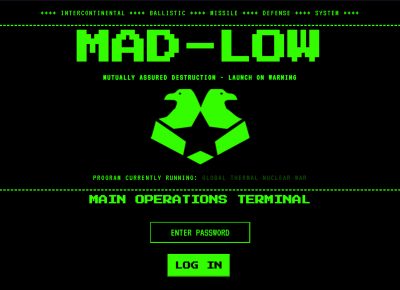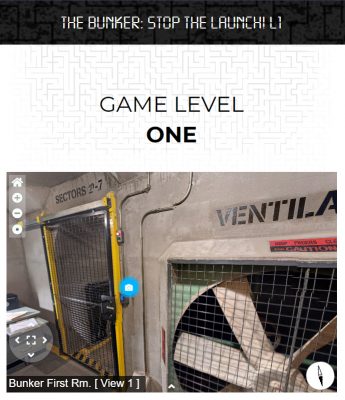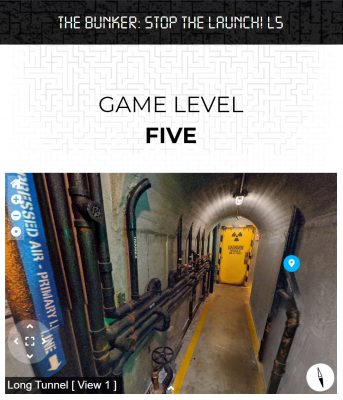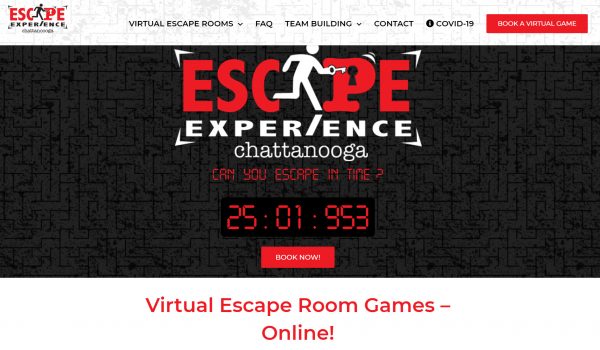RATING: 5 Keys RESULT: Win REMAINING: 0:56
From the comfort of our own personal bunkers, we dial in remotely to another to stop a nuclear armageddon – without ever leaving the house.
The Bunker is an existing, physical escape game at the venue’s brick and mortar location – retrofitted to be offered as a live, online remote play experience. Although altered slightly to better flow in this new medium, the game is, at it’s core, essentially the same as what guests will find should they visit Escape Experience Chattanooga in person. You can find our companion review of the brick and mortar version of this game here.


 The date is August 1, 2009, and you are the first to arrive at your new military post inside the Ochs-Bragg Missile Complex (OB-16.12). Shortly after your arrival, a sudden event inexplicably triggers a total lockdown of all doors and controls and immediately initiates what appears to be an automated missile launch countdown. Can you stop the launch, prevent a global nuclear war, and retreat to the radiation-free safe zone before it’s too late?
The date is August 1, 2009, and you are the first to arrive at your new military post inside the Ochs-Bragg Missile Complex (OB-16.12). Shortly after your arrival, a sudden event inexplicably triggers a total lockdown of all doors and controls and immediately initiates what appears to be an automated missile launch countdown. Can you stop the launch, prevent a global nuclear war, and retreat to the radiation-free safe zone before it’s too late?
The Ochs-Bragg Missile Complex is a highly secure facility housing a host of nuclear weapons dating back to the Cold War. As such, the utmost levels of security protocol must be in place. As senior ranking officials, our team must check in remotely from time to time to ensure all is operating efficiently and according to procedure.
During a routine debrief with a new on-site agent physically inside the bunker, a worst case scenario becomes reality; the Mad-Low control system triggers, initiating launch protocol that will not only deploy a number of nuclear devices, but fill the bunker itself with radiation. Remotely commuting senior officials are left with two objectives: stop the launch to prevent a potential World War, while also guiding the unprepared on-site field operative on a path to safety from the impending radiation.
Escape Experience Chattanooga immediately sets the stage, drawing senior officials into this very real story world, despite not even physically being within the actual space. Importantly, justification is given for why the team is each logged in remotely, taking what would otherwise be a basic Google Hangouts call and turning it into an immersive adventure that evokes a true sense of very real consequences.

 As we’ve discussed previously in The Bunker’s brick and mortar review, the scenic attention to detail here carries an authenticity allowing even the most critical of agents to suspend disbelief. There’s little question for those physically on-site that they are underground in a secure bunker complete with rounded passageways and poured concrete floors, echoing with war-like noises overhead. The entire game space is much bigger than one might guess, thanks to a very well-hidden secret passage.
As we’ve discussed previously in The Bunker’s brick and mortar review, the scenic attention to detail here carries an authenticity allowing even the most critical of agents to suspend disbelief. There’s little question for those physically on-site that they are underground in a secure bunker complete with rounded passageways and poured concrete floors, echoing with war-like noises overhead. The entire game space is much bigger than one might guess, thanks to a very well-hidden secret passage.
At the risk of taking priorities out of order, the first question on the mind of senior officials might be how something of this scale can translate in a remote play environment. (We promise the notion of stopping nuclear annihilation was only a close second thought!) The Bunker’s remote play experience begins as our operative in the field activates his live video feed, revealing the impressively themed exterior portal to The Bunker itself. Opening the door, he enters the compound while debriefing senior officials – our remote team – on the working conditions of the facility. In real time, chaos ensues before our eyes, as at-home computer screens flash with warnings of The Bunker’s lock down and impending missile launch. In effect, this remote introduction to the physical space serves as a surprise pre-show for the experience to come.
This first impression also quickly reveals just how vital the on-site operative is. Pealing back the storyworld for a moment to look behind the curtain, this is a whole new world for any gamemaster – one where they need to be as much a performer as a hint system. The best remote play experiences will utilize staff who are able to exhibit strong improvisational skills – after all, it is solely on their shoulders to bring these experience remotely to life for those of us playing along from home. In essence, for this to work well, the gamemaster almost needs to do everything one normally might avoid in a brick and mortar game – constantly talking to the players throughout the experience and never letting things slow down. While this might normally seem like a negative, remote play games are far from “traditional,” and in effect, this constant gamemaster interaction becomes the very pulse of the experience from start to finish. We quickly recognized how solidly Escape Experience Chattanooga’s team recognized this fact.
As the mission progresses, vital documents are shared through Google Hangouts’ chat window. These include things agents might expect, such as digital scans of important documents scattered around the Ochs-Bragg Missile Complex, misplaced ID badges and representations of other physical items. Adding a welcome touch of immersion, our on-site field agent physical “scans” each item with a hand-held laser before it becomes digitally available to us, giving the impression that he’s uploading them for the first time that very moment. Most impressively – and incredibly helpful – fully interactive 3D photo tours of each sector of the compound are uploaded as each new room unlocks as agents actually encounter them, allowing senior officials to actively search the space as if they were there in person. And of course, our on-site field agent is suited up with a live camera and microphone, allowing us to see and hear everything in real time.

 Navigating The Bunker will require strong communication skills with the on-site operative. Lacking experience and proper training, this is a terrible time for anyone’s first day on the job. As such, it becomes the role of senior officials to guide the mission to success from afar. Clear direction will be needed to essentially maneuver this live agent around the physical space, following his progress on camera feeds. Senior officials will execute the orders of what to look at, where to search, and what codes to enter.
Navigating The Bunker will require strong communication skills with the on-site operative. Lacking experience and proper training, this is a terrible time for anyone’s first day on the job. As such, it becomes the role of senior officials to guide the mission to success from afar. Clear direction will be needed to essentially maneuver this live agent around the physical space, following his progress on camera feeds. Senior officials will execute the orders of what to look at, where to search, and what codes to enter.
Beyond communication, organization in these remote play environments is almost equally critical. As documents and key objects are discovered, senior officials will quickly realize there is a lot to sort through. What might not come even close to daunting in a physical room, where one can hold each item in their hand and compare them side by side can, may become quickly overwhelming in a digital world. Suddenly, those items are far less tangible, turning each from identifiable, distinct objects to countless open tabs on an internet browser. One could debate the pros and cons, but simply put – it’s just a new and unique style of game play that even the most experienced of players will find themselves suddenly needing to adjust to from square one.
The Bunker’s remote play option offers a nearly identical course of puzzles to its existing brick and mortar game, with some caveats. Certain parts of this mission have been streamlined to flow in a bit more of a linear fashion, which is critical to this new medium. This game also features some physical tasks which have been tweaked and in some cases circumvented to make the experience a bit more online-friendly.

There’s one phrase that we’ve used in these past few weeks more times than our team has collectively uttered in our lifetimes: uncharted waters. It truly applies to much of the world around us in these uncertain times, but, perhaps in a sense even more so to the new genre of remote play escape games. Suddenly, it doesn’t matter if you’ve played ten, fifty, a hundred, or five hundred different escape games. When entering this new digital world, we’ve all, in effect, been reset to one. Everything you think you know – every strategy that you’ve learned along the way – in a sense, is wrong. Truly, these are uncharted waters.
It is possible that some experienced players may initially find frustration in a remote play environment; our advice is take a breath and stick with it. It’s critically important to remember that together, we’re all essentially learning a brand new skill set. Just as venues are learning how to even run a brick and mortar game remotely over the internet, we, the players, have to be patient and essentially learn how to play them.
Try to think back to your first real escape game experience. Try to forget everything you know from dozens – or even hundreds – of games that you may have played since. On that first game, none of us instinctively knew to gather all of the evidence – each found object – into a single centralized location to begin analyzing how they may connect with the environment around us. None of us instinctively knew to immediately survey the room from top to bottom to take inventory on what types of codes we need to solve for, or how many keys we might need to obtain. All of these things that are, today, simply second nature to experienced players were learned skills that we’ve each developed through experience. With remote play games, we need to develop a whole new set of skills and learn to play differently.
A few protips we’ve quickly learned are to use your personal home environments to the best of your abilities while playing a remote game. Do you have multiple monitors on your computer? If so, cast one as your live video feed of the room, with a second as a window solely to display clues, items and vital objects found in digital form. Keep your tabs organized; try to rearrange them so that like objects sit next to each other across the top of the browser, making them easier to locate quickly. To the same point, keep your work space “clean” by closing tabs of any completed or used items, in an effort to limit what’s left in front of you. Perhaps the best method we’ve found, though, admittedly won’t be as readily available to all players. Do you have Adobe Photoshop, or a similar graphic design program on your personal computer? If so, we recommend copy/pasting all of these digital assets onto a single work space. Although this takes a few minutes to organize up front, once implemented, it allows remote players the ability to see everything side by side, in scale, to compare each object exactly as they would in a brick and mortar experience.
Escape games have always been about thinking outside the box, problem solving and finding solutions in often unexpected ways. With this new genre of remote play games, that notion has never been more true. One could debate the merits of playing physical games versus remote experiences – but at the end of the day, the simple fact is that they are different. Is one better than the other? Maybe – but the key is they are different in such a way that they each are an enjoyable experience. And for now, while we’re figuratively locked in our own respective bunkers, this new genre of the industry offers the one thing we truly need most: an escape from reality around us, to “gather” safely with our closest friends. But this time, we get to do it no matter where they may be in the world, joined in a common experience that brings us all together in a way that, before today, was never even possible.
*Montu, Escape Authority’s VP, Dog Business™ and lead home game correspondent endorses the opinions found within this review.
Show your support for Escape Authority and get social with us:

Venue: Escape Experience Chattanooga
Location: Remote online play at home, broadcast live from the venue in Chattanooga, TN
Number of Remote Games: 2
GAME SPECIFIC INFORMATION:
Duration: 60 minutes
Capacity: 8 people
Group Type: Public / You may be paired with strangers.
Cost: $25 per person

We thank Escape Experience Chattanooga for inviting us to play this game. Although complimentary access was generously provided, that in no way impacts the opinion included within this review.



















